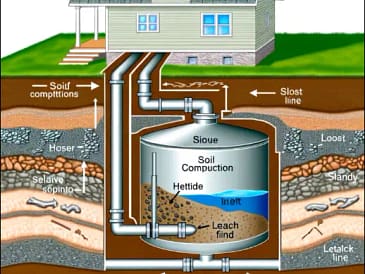Your septic system is out of sight but should never be out of mind.
If you’ve ever dealt with foul odors, slow drainage, or costly plumbing emergencies, chances are poor maintenance is to blame.
Creating a proactive septic system maintenance calendar is the easiest way to stay ahead of problems and save thousands in preventable repairs.
Understanding Your Septic System Basics
Before you can maintain what you don’t fully understand, it’s important to get familiar with the basics of your home’s septic system. The three main components are the septic tank, the drainfield (also called a leach field), and the piping system that connects your home’s plumbing to the tank.
Your septic tank holds and separates solid and liquid waste. Solid waste settles at the bottom as sludge, while lighter materials float to the top as scum. The clarified liquid in the middle flows into the drainfield, where it’s filtered naturally through soil. When functioning efficiently, this system can last for decades.
However, without proper upkeep, parts may fail prematurely. With routine care, your septic tank can last 20-40 years, while your drainfield can stay effective for 25+ years. This longevity hinges entirely on how well you maintain the system.

Why a Septic Maintenance Calendar Is Essential
Neglect is the fastest way to turn your backyard into a biohazard. A well-planned septic maintenance calendar protects your system and your wallet. Regular maintenance helps prevent backups, overflows, and even system failure.
Many local ordinances now require routine inspections and maintenance, especially in environmentally sensitive areas. Staying compliant avoids fines and keeps your property in good standing.
Besides regulatory obligations, an efficient septic system directly impacts your home’s value. A well-maintained system signals to buyers that the house has been cared for, while a failing one can scare buyers off completely.
Key Maintenance Tasks to Include in Your Calendar
Pumping the Septic Tank
Generally, your tank should be pumped every 3 to 5 years. However, if you have a large household or a garbage disposal, more frequent pumping may be necessary. Signs that it’s time include slow drains throughout the house, gurgling pipes, or a strong sewage odor outside.
Routine Inspections
Schedule professional inspections at least once a year. Inspectors will check sludge levels, look for signs of leaks, and assess the condition of your tank and drainfield. Keeping tabs on these factors can prevent bigger issues down the line.
Drainfield Care
Never park or place heavy objects over the drainfield. Compacting the soil limits its ability to filter waste. In the winter, avoid snow compaction, and during spring, check for soggy ground that could indicate a malfunction.
Water Usage Management
Being mindful of water use reduces stress on your septic system. Spread out laundry days, fix leaky faucets, and install water-efficient appliances. Overloading the system with too much water can force solids into the drainfield.
Waste Disposal Practices
Only flush human waste and septic-safe toilet paper. Never pour things like grease, coffee grounds, feminine hygiene products, or harsh chemicals down the drain. These items can kill helpful bacteria in your tank or clog your system.
Monthly, Seasonal, and Annual Maintenance Schedule
Monthly Checklist
Each month, keep an eye on water consumption. A sudden spike might indicate a leak. Walk around your yard and look for wet patches or unusual odors—both are red flags that require attention.
Quarterly Tasks
Every three months, observe drainage speed in sinks, showers, and toilets. If you’re using a biological additive recommended by a professional, track these applications quarterly as well.
Seasonal Considerations
In colder climates, winterize your system in the fall. Insulate exposed pipes and reduce soil compaction from snow and foot traffic. Come spring, do a system walkthrough to spot new issues caused by frost or runoff.
Annual Maintenance
Once a year, call in the pros. A certified septic inspector will give your system a thorough exam. Depending on your usage and the results, this is also the best time to schedule a pump-out.
How to Customize Your Maintenance Calendar
Not all septic systems are the same, and your calendar should reflect your unique situation. Start by evaluating your household’s water patterns. Larger families or homes with high water usage might need more frequent inspections or pumping.
The age, design, and condition of your system also influence your maintenance schedule. If you’re unsure, your original installer or a qualified inspector can provide insights. Follow manufacturer guidelines, especially for newer or advanced treatment systems.
Use digital tools and phone apps to create recurring reminders. Setting calendar events or smart home alerts ensures you never forget a crucial maintenance step again.
Tools and Resources for Maintaining a Septic Calendar
Several tools are available to simplify your record-keeping. Septic maintenance apps—like Septic Tracker or HomeZada—allow you to log service history and set reminders with ease. If you’re more of a pencil-and-paper type, printable maintenance calendars do the job just fine.
Home maintenance software such as Centriq or Househappy can store detailed documents, including inspection reports and service provider contacts. Keep a list of local septic professionals handy in both your phone and printed form for emergencies.
Common Mistakes to Avoid
Skipping a pump-out to save money is a false economy. A single tank clean-out might cost a few hundred dollars, but system replacement can run into tens of thousands. Don’t ignore warning signs like slow drains or wet ground.
Be vigilant about what goes down your drains. Flushing wipes, cat litter, or toxic chemicals is a fast track to system damage. Also, avoid planting trees or shrubs near the drainfield. Roots can easily grow into pipes, causing blockages and damage.
When to Call a Professional
Certain problems shouldn’t be tackled solo. If you’re experiencing strong sewage smells, slow water drainage, or gurgling noises in your plumbing, it’s time to call in help. Don’t wait until things get back up in your home.
A professional inspection and report will be expected if you’re buying or selling a home with a septic system. Schedule this service early to avoid closing delays.
As the EPA states, “A properly designed, constructed, and maintained septic system can provide long-term, effective treatment of household wastewater.” Don’t take risks with DIY solutions—invest in regular professional help.
Conclusion
Sticking to a consistent septic maintenance schedule is one of the smartest things you can do as a homeowner. From regular inspections to mindful water use, each task on your calendar helps avoid costly disasters and extends the life of your system.
Your septic system won’t manage itself. With a personalized, easy-to-follow calendar, you’re one step ahead of breakdowns, fines, and unexpected expenses. Take charge now—your home and environment will thank you for years to come.





